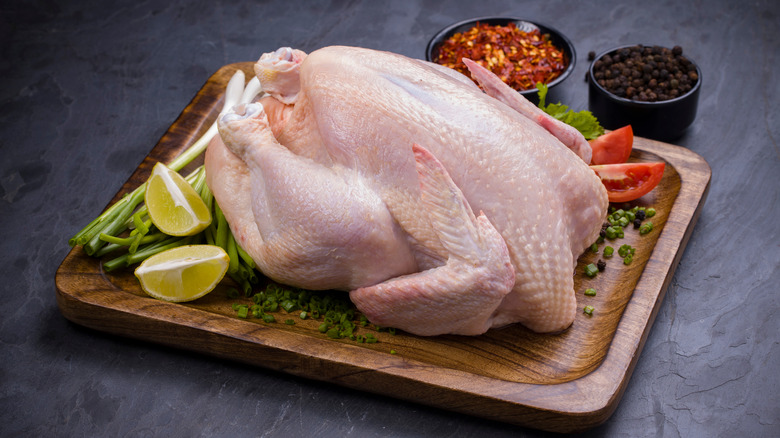What Do The USDA Chicken Grades Mean?
The United States Department of Agriculture (USDA) has specific guidelines and regulations when it comes to inspecting and grading the quality of meat. According to the North Carolina Department of Agriculture and Consumer Services (NCDA&CS), inspecting meat is required by the USDA before it's able to be sold to consumers. In contrast, grading meat is an optional step left to the discretion of individual meat processors. The USDA has its own inspection service known as the Food Safety and Inspection Service (FSIS), and it's responsible for inspecting imported, foreign, and interstate meat and poultry products, as well as continuing the inspection process once the products are shipped to other processing plants. The cost of the inspection process is covered by tax dollars.
The process of grading meat and poultry is handled by the USDA's Agricultural Marketing Service (AMS) and is requested and paid for by the meat processor. While grading meat isn't required by the USDA, there are federal standards set to ensure that meats are graded the same way. Beef, lamb, pork, veal, and poultry have different grades, and if meats have been graded, some scores will be visibly shown on the packaging. Chicken and other poultry are graded based on specific characteristics regarding their shape, overall appearance, bones, fat, skin, and more, and they can be classified as either Grade A, Grade B, or Grade C. If you see a USDA grade on the chicken's label, here's what it means.
Raw chicken and other poultry are graded based on quality and appearance
Per the NCDA&CS, Grade A chicken and other poultry is the only grade available for purchase in grocery stores. This superior grade is given to raw poultry meat with no discoloration, bruising, or feathers. If the specific cut of meat contains bones, such as wings or drumsticks, the bones must not be broken. Cuts of poultry with the skin intact must not have rips or holes in the skin to where the meat is showing and must have a substantial amount of fat between the skin and the meat. According to the USDA, Grade A poultry meat must also be "well fleshed" and have a bright, clean appearance.
Chicken and other poultry deemed Grade B or C usually won't be sold to consumers as they are. Instead, the meat will be ground or cut up and used in other products. If either of these two grades does happen to be sold to consumers, the packaging typically won't reveal the grade. Grade B chicken may have slight deformities such as dents, curves, or crooks in the meat or bones that don't greatly affect the appearance or the flesh, while Grade C chicken will have more unusual abnormalities that severely diminish the appearance, per the USDA. Furthermore, Grade B chicken may have disjointed bones but can't have broken bones, and Grade C chicken will have bones that are disjointed and broken.

